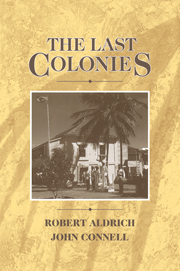Book contents
- Frontmatter
- Contents
- List of Maps and Tables
- Acknowledgements
- Abbreviations
- Overseas Territories
- Inset 1: Central Pacific Ocean
- Inset 2: Caribbean Sea
- The Western Mediterranean
- Dedication
- 1 The Legacy of Empire
- 2 Constitutional Issues
- 3 The Economic Transition
- 4 The Quest for Independence?
- 5 Military Bases, Geopolitical Concerns
- 6 Disputed Territories, ‘Colonial’ Conflicts
- 7 The End of Empire?
- Appendix: Profiles of Overseas Territories
- Notes
- Index
7 - The End of Empire?
Published online by Cambridge University Press: 19 January 2010
- Frontmatter
- Contents
- List of Maps and Tables
- Acknowledgements
- Abbreviations
- Overseas Territories
- Inset 1: Central Pacific Ocean
- Inset 2: Caribbean Sea
- The Western Mediterranean
- Dedication
- 1 The Legacy of Empire
- 2 Constitutional Issues
- 3 The Economic Transition
- 4 The Quest for Independence?
- 5 Military Bases, Geopolitical Concerns
- 6 Disputed Territories, ‘Colonial’ Conflicts
- 7 The End of Empire?
- Appendix: Profiles of Overseas Territories
- Notes
- Index
Summary
Fundamental changes in the global political order in the past decade have thrown open complex issues of sovereignty, territoriality and nationhood. Questions of what constitutes nation-states, relations between nation-states and their constituent peoples and territories, and the nature of national sovereignty are no longer so clear-cut as they once seemed. In many places nationalists press for smaller states, which might not be fundamentally different from those whose dominance their advocates resist so passionately. Tensions between indigenous peoples, ethnic minorities, and modern nation-states take many forms, though most are concerned with some combination of issues concerning cultural identity and resource sovereignty. Vague attempts to construct from above a ‘New World Order’ have been met by a myriad of efforts to construct another new world order, rather closer to the ‘bottom’, that have challenged the centralised power of major nation-states and global institutions. These efforts have transformed global cartography, especially in the post-socialist states, and within nation-states have produced legislative changes aimed at granting increased sovereignty to indigenous people. Thus in Canada, for example, the Nunavut nation now has special status, and in Australia Aboriginal nations, such as the Jawoyn, are moving to a form of national statehood within a nation-state. Established federal states – from the Federated States of Micronesia to the United States – provide further complexities of scale, legitimacy and competing constitutional regimes.
- Type
- Chapter
- Information
- The Last Colonies , pp. 235 - 251Publisher: Cambridge University PressPrint publication year: 1998

